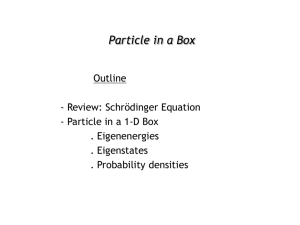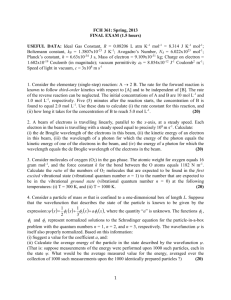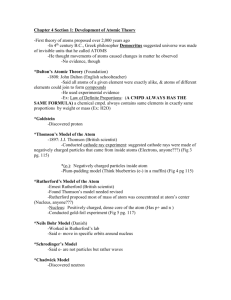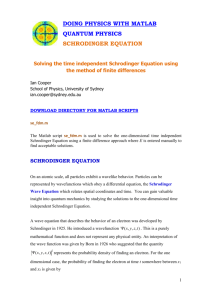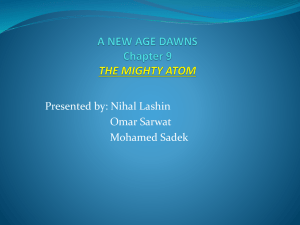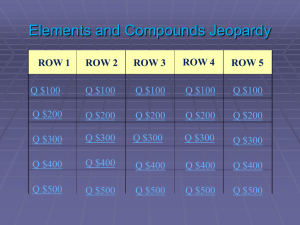Simulating the behavior of an atomic sample traveling around a ring
advertisement
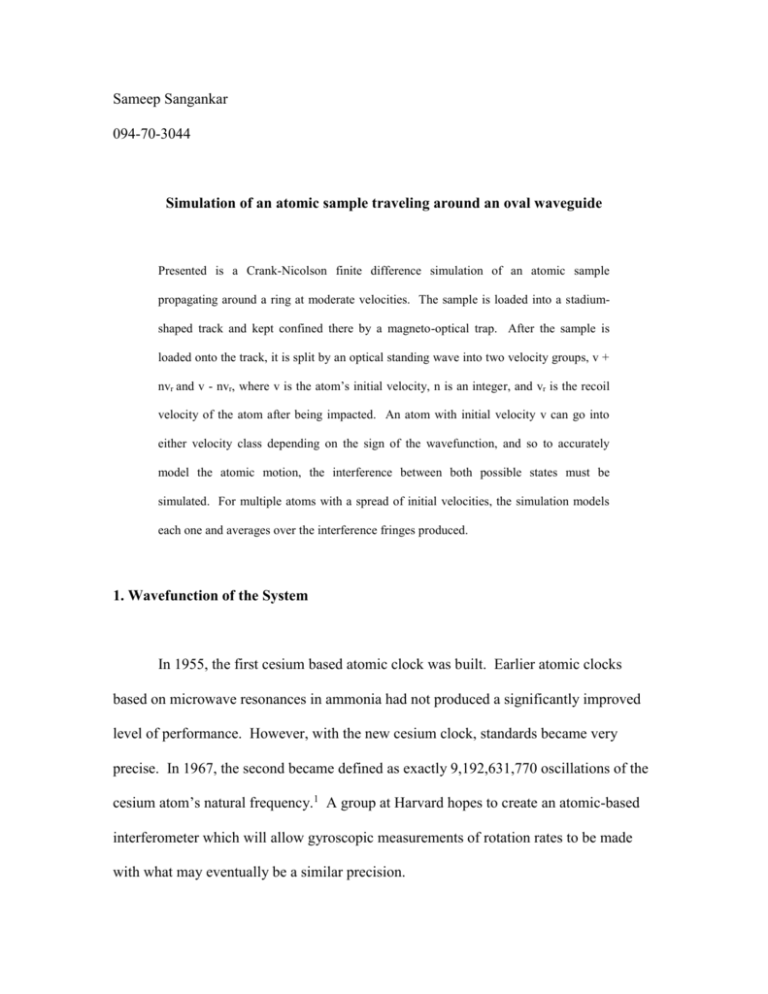
Sameep Sangankar 094-70-3044 Simulation of an atomic sample traveling around an oval waveguide Presented is a Crank-Nicolson finite difference simulation of an atomic sample propagating around a ring at moderate velocities. The sample is loaded into a stadiumshaped track and kept confined there by a magneto-optical trap. After the sample is loaded onto the track, it is split by an optical standing wave into two velocity groups, v + nvr and v - nvr, where v is the atom’s initial velocity, n is an integer, and vr is the recoil velocity of the atom after being impacted. An atom with initial velocity v can go into either velocity class depending on the sign of the wavefunction, and so to accurately model the atomic motion, the interference between both possible states must be simulated. For multiple atoms with a spread of initial velocities, the simulation models each one and averages over the interference fringes produced. 1. Wavefunction of the System In 1955, the first cesium based atomic clock was built. Earlier atomic clocks based on microwave resonances in ammonia had not produced a significantly improved level of performance. However, with the new cesium clock, standards became very precise. In 1967, the second became defined as exactly 9,192,631,770 oscillations of the cesium atom’s natural frequency.1 A group at Harvard hopes to create an atomic-based interferometer which will allow gyroscopic measurements of rotation rates to be made with what may eventually be a similar precision. The principle of operation of the interferometer is based on the motion of low temperature rubidium atoms confined to a track confined to a stadium-shaped loop. For a quantum mechanical particle, classical trajectories do not apply, even on a macroscopic scale. Ordinarily, quantum effects on a small scale are washed out by the sheer number of particles present or simply too small to be observed. The rubidium atoms are lasercooled to very low temperatures, such that their mean velocity is around 15 cm/s. An individual rubidium atom has a mass of 1.44316*10-22 g; approximately 200,000,000 atoms are loaded into the trap in each sample. Using the de Broglie relation, λ = h/p, where h is Planck’s constant and p is the particle momentum, the wavelength of the sample is found to be 3.06091*10-5 cm, giving a wavenumber of 205272 cm-1. Once the atoms are loaded into the trap, the time evolution of the system is given by the Schrodinger equation: iħut = -(ħ2/2m)uxx + V(x)u = Hu where ħ = h/2π, V(x) is the potential at each point in the domain, m is the particle’s mass, H is a shorthand operator notation for the term in the middle, and u(x,t) is the wavefunction describing the particle’s state and trajectory. The Schrodinger equation is analogous to the Lagrangian in classical physics, but the meaning of the solution is somewhat difficult to make out at first glance. In 1924, physicist Max Born proposed that the wavefunction is not a physically observable quantity, but the square of the wavefunction at point (x, t) gives the probability of finding the particle at a point x at time t. The wavefunction itself is not a directly measurable quantity; rather it encodes all the information about the particle that can be determined through observation. Rescaling the constants, so that ħ = m = 1, we are left with a parabolic differential equation in x and t. The general solution to this equation is given by a linear superposition of individual wave solutions: u = ∑ A(x)ei(kx-ωt) After the atoms are loaded onto the ring, the sample is pulsed by a standing optical wave tuned to the resonant frequency of rubidium. The photon impacting on the sample provides a “kick” either towards the left or the right. Thus, the resultant general solution is a superposition of each atom traveling either towards the left or the right. As they travel around the ring, the waves meet and interfere with each other. That is to say, the possible rubidium atom traveling to the left interferes with the possible rubidium atom interfere traveling to the right, producing an interference pattern when observations of the state of the sample are made. The amplitude factor (A(x) in the above equation) is given by a normal distribution. Hence the initial state of solution being modeled in the system is given by: u(x,0) = (2/(πσ))1/4e-x^2/2σ(ei(k+s)x + ei(k-s)x) where σ is the width of the gaussian (normal) distribution at half maximum, and k and s are the initial velocity (k) and the recoil velocity of the atom after being impacted (s). The reason the amplitude is given by a gaussian is because of the Heisenberg uncertainty principle. The sample is initially loaded at a specific point on the track; however, the uncertainty inherent in the particle’s location gives the wavefunction some spread around the initial point. The Schrodinger equation describes waves in a dispersive medium; that is to say, there is a relation between ω and k (ω = -k2). Since the speed of a wave is always given by c = ω/k, not all waves will travel at a uniform speed. In fact, for particles described by a gaussian distribution, the wavefunction will spread out in space as the different Fourier components of the function move away at different speeds. For our system, the gaussian peak will spread and will also ride the waves going in either direction, with a speed given by the group velocity vg = dω/dk = -2k. 2. Numerical Simulation In many instances, when there is no potential function, the Schrodinger equation can often be solved and integrated exactly, often producing simple and easily understood solutions such as the famous “particle in a box.” However, adding a potential function complicates the equation enough that finding the exact time evolution is often impossible. Thanks to the speed of modern computers, however, numerical approximations can be made which produce solutions very close to the exact solution. The method used here is called a Crank Nicolson finite-difference method. The idea behind numerical approximation to partial differential equations is to discretize the domain in both space and time and then compute the evolution of the system as a series of points in a domain jumping from one time t to the next. The exact time evolution of the system can be represented as an operator by integrating the Schrodinger equation: W = e-iHt. Let unj = u(jΔx, nΔt). Discretizing in space and time gives: un+1j = Wunj = e-iHΔtunj ~ (1 – iHΔt)unj uxx = (unj+1 + unj-1 - 2unj)/Δx2 where the approximation to W is given by Taylor expansion and uxx is a second order finite difference approximation. The Crank Nicolson method is then given by: un+1j = (1 – iHΔt)unj un-1j = (1 + iHΔt)unj Combining the two we get: (1 + iHΔt)un+1j = (1 – iHΔt)un-1j Giving: [1 + i(2α + VjΔt)]un+1j – iα(un+1j+1 + un+1j-1) = [1 - i(2α + VjΔt)]un-1j + iα(un-1j+1 + un-1j-1) 2 Where α = Δt/Δx2 The MATLAB program submitted with the report calculates a number of things. The top window shows the evolution of the wavefunction according to the Crank Nicolson approximation up till the entered end time. The second window shows the probability amplitude of the wavefunction, given by its square. Finally, the last window shows the intensity of the desired number of samples of different speeds averaged over. The fringe contrast at the origin at the time the two atoms meet (given by t = 11.2/(2k), where 11.2 cm is the length of the circumference of the track) is also calculated and displayed. To change the fringe contrast from the meeting time to the end time, line 73 can be changed from cut = q(f:g); to cut = y(f:g). The Crank Nicolson method has no stability restrictions, so any value of Δx and Δt can be entered. converge.m plots the sum of the probability amplitude across x for varying values of Δx and plots the results versus Δx. The parameters can be varied in the code. Bibliography 1. http://physics.nist.gov/GenInt/Time/atomic.html 2. Askar & Carnak, Explicit integration method for the time-dependent Schrodinger equation for collision problems, J. Chem. Phys. 68 pp. 2794 3. S. Wu, et. al, Bidirectional propagation of cold atoms in a “stadium” shaped magnetic guide, preprint 4. Feynman Lectures on Physics, vol. 2


